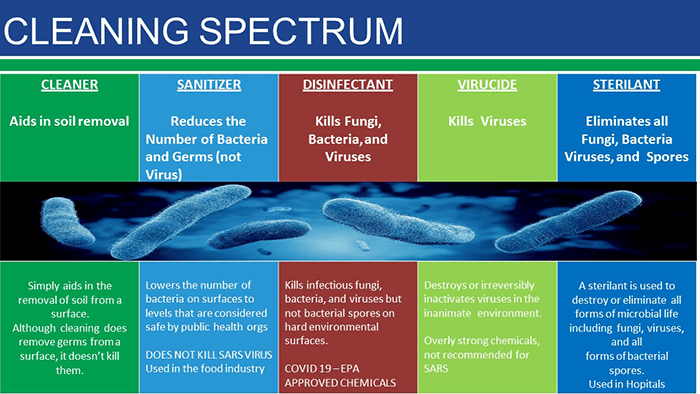Disinfectant vs Sanitizer: What is the difference
Table of Contents
We’ve all got to “up our game” when facing COVID-19 aka Corona virus.
Remember when the verb “to clean” was sufficient? When things were dirty, you just hired cleaning services, and they cleaned it. So simple.
Today, as we fight a very contagious and persistent virus, we need to be more explicit about our practices. Here are definitions, courtesy of EnvirOx, a manufacturer of cleaning products.
Cleaner: Aids In Soil Removal
Simply aids in the removal of soil from a surface. Although cleaning does remove germs from a surface, it doesn’t kill them.
(From NPR: “Cleaning can remove ― but not necessarily inactivate — viruses, though because all coronaviruses are encased in fatty envelopes, there is good reason to think that the same soaps that break down grease can puncture that outer envelope and inactivate the coronavirus, too.”)
Sanitizer: Reduces The Number Of Bacteria
Lowers the number of bacteria on surfaces to levels that are considered safe by public health orgs.
Disinfectant: Kills Fungi, Bacteria & Viruses
Kills infections fungi, bacteria and viruses, but not bacterial spores on hard environmental surfaces. (Check the following link here for the EPA’s list of approved disinfectants for use against SARS-CoV-2, the cause of COVID-19.)
Virucide: Kills Viruses
Destroys or irreversibly inactivates viruses in the inanimate environment.
Sterilant: Eliminates All Fungi, Bacteria, Viruses & Spores
A sterilant is used to destroy or eliminate all forms of microbial life including fungi, viruses and all forms of bacterial spores.
Infectious Agents Explained
Which brings us to the question: What’s the difference between a virus and a bacterium? Here you can read some information directly from the Mayo Clinic.
Infectious Agents Come In Many Shapes & Sizes. Categories Include:
Viruses are much smaller than cells. In fact, viruses are basically just capsules that contain genetic material.
To reproduce, viruses invade cells in your body, hijacking the machinery that makes cells work.
Antibiotics designed for bacteria have no effect on viruses. Virus-caused diseases include: COVID-19, AIDS, common cold, Ebola virus, genital herpes, influenza, measles, chickenpox and shingles.
Bacteria are one-celled organisms that can be seen only with a microscope. Some infections caused by bacteria include strep throat, tuberculosis, urinary tract infections.
(From microbeonline.com: “Bacterial spores are highly resistant, dormant structures (i.e. no metabolic activity) formed in response to adverse environmental conditions. They help in the survival of the organisms during adverse environmental conditions; they do not have a role in reproduction.”)
There are many varieties of fungi, and we eat several of them. Other fungi can cause illness, for example candida, thrush, athlete’s foot and ringworm.
Protozoans are single-celled organisms that behave like tiny animals — hunting and gathering other microbes for food. Diseases they cause include giardia, malaria, toxoplasmosis.
Helminths are among the larger parasites, including tapeworms and roundworms.

Stay Safe, Be Kind And Wash Your Hands!
We hope this information provides some clarity to you in these uncertain times.
Every adversity carries some kind of silver lining: We all benefit by improving our understanding of the different ways disease is spread, and how to mitigate risks and keep things truly, functionally clean.
At Ana Cleaning Services, LLC we are here for you, more than ever.
If we can be of service to you, please give us a call at 240-485-4045


Recent Comments